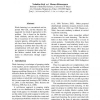Free Online Productivity Tools
i2Speak
i2Symbol
i2OCR
iTex2Img
iWeb2Print
iWeb2Shot
i2Type
iPdf2Split
iPdf2Merge
i2Bopomofo
i2Arabic
i2Style
i2Image
i2PDF
iLatex2Rtf
Sci2ools
91
Voted
COLING
2008
2008
Using Hidden Markov Random Fields to Combine Distributional and Pattern-Based Word Clustering
Word clustering is a conventional and important NLP task, and the literature has suggested two kinds of approaches to this problem. One is based on the distributional similarity and the other relies on the co-occurrence of two words in lexicosyntactic patterns. Although the two methods have been discussed separately, it is promising to combine them since they are complementary with each other. This paper proposes to integrate them using hidden Markov random fields and demonstrates its effectiveness through experiments.
COLING 2008 | Computational Linguistics | Distributional Similarity | Important Nlp Task | Word Clustering |
Related Content
| Added | 29 Oct 2010 |
| Updated | 29 Oct 2010 |
| Type | Conference |
| Year | 2008 |
| Where | COLING |
| Authors | Nobuhiro Kaji, Masaru Kitsuregawa |
Comments (0)

